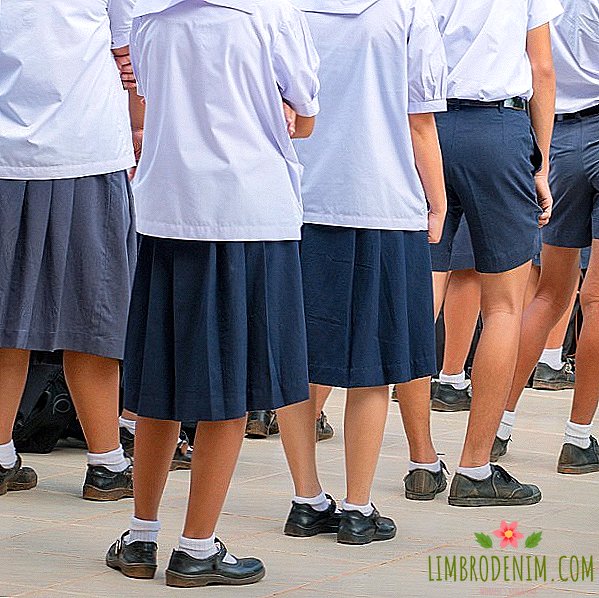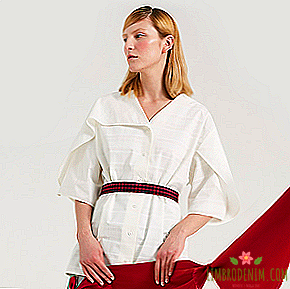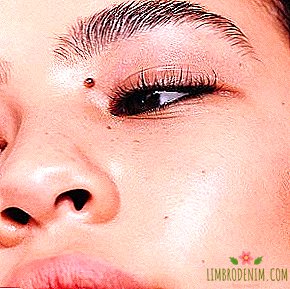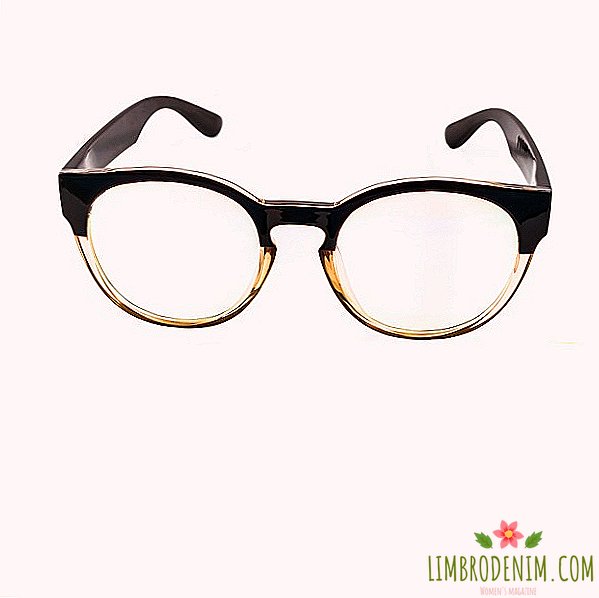One size fits: Who needs a school uniform and face control
SCHOOL UNIFORM - One of the most controversial issues of the Russian education system. Acquaintances from photographs of parents and Soviet cinema outfits were introduced in 1948 and existed until 1992. Post-war standards regulated everything up to the hairstyles: boys were cut to zero, boys to half-boxes; girls were allowed only long, tied ribbon braids. Haircuts, cosmetics, jewelry were excluded completely. Violators, as now, were punished by teacher hysterics, notes in diaries and did not allow lessons. In 2013, it was decided to return the compulsory school uniform. But the way in which this is done is left to the discretion of the schools themselves.
Supporters of school uniforms rest mainly on the order - the competition of knowledge against the competition of looks. Most of the current students have parents who grew up in the USSR. Many, of course, hated the prickly brown gown of cloth, but someone is nostalgic for the rules and is tired of choosing what to wear this morning. Others, by the same Soviet habit, are trying to save a child from envy of better-off peers, not realizing that they are compensated primarily for their own complexes or financial problems.
School uniform advocates like to refer to the western experience: in elite schools, for example, Great Britain, the rules of appearance are much more stringent than in Russia. However, schools with the name produce their own sets of clothes and treat them more like a merchandise or a tracksuit for competitions: the uniform in this case enhances the students' team spirit and the alma mater's loyalty. All these are military habits, opponents parry, and the desire to equalize children is the first step towards their discrimination and ignoring natural and social diversity, so encouraging it is at least inconsistent.
We talked with students and teachers and found out how far educational institutions go in trying to control the wards' appearance and what psychologists and lawyers think about it.

A young teacher named Anna began working at the school shortly before the introduction of the new regulations. “At first, the dress code was“ as if not in jeans ”(everyone went), and then we were merged with the gymnasium and rolled out a list of requirements: blue clothes, extremely classic trousers, jeans and sneakers could not be worn,” she recalls. And all these rules began to be violated with the onset of puberty - when parents stop putting clothes on the bed, first of all it is connected with banal inconvenience: sweater and skinny are cozier than classical trousers and shirts, sneakers are more comfortable than shoes.doing. " Some requirements even surprised the girl herself: black tights and loose hair fell under the ban. The latter was decided by itself, when an epidemic of head lice began in Anna’s class - you want it or not, you had to be strict. Surprisingly, colored hair did not fall under the dress code: sixth grade students boldly dyed the tips of the strands in green and pink, and none of the teachers said a bad word to them.
Teacher Ivan Sorokin believes that school uniforms as an idea are good primarily because they work directly as an element of smoothing social inequality: "When you have a little less opportunity to demonstrate excellence with clothes, jewelry and cosmetics, the atmosphere in the classroom and school In general, it becomes less stressful. At the same time, I am against the global form, but for some of the elements: we had sweaters and vests, somewhere - jackets. It’s quite possible to show individuality. " In addition, according to the teacher, the form can help students feel themselves part of something more than just a class - and this feeds the "feeling of elbow."
Anything that is not allowed is forbidden: too loose or too tight clothes, too creative haircuts or complete disregard for them, knitwear, manicure and makeup, except for masking
In practice, attempts to regulate the observance of the dress code by teachers and class teachers often turn into trespassing: school employees give recommendations on the type of body, not just clothes. This is how it is at the school where Amu, an eighth-grader, is studying (her name was changed at the request of the heroine): "In the summer I painted myself orange. My parents reacted to this normally, but when I came to school on September 1, the headwoman came to me and told me I changed my hair color to “more adequate.” For this, I have neither money, nor time, nor, especially, a desire, so I try to make my hair more inconspicuous - my mother helps to braid them in braids. But still there are teachers who the color is like, and it's very nice. "
The document referred to in Amu’s school is called the Regulations for Establishing Requirements for Pupils' Clothes. In addition to those who have slandered “creating a working atmosphere” and “creating a sense of corporate identity,” there are such surprising speech turns as “masking makeup” and “hair of unnatural shades”. In other words, everything that is not allowed is forbidden: too loose or too tight clothes, too creative haircuts or complete disregard for them, knitwear (except for "one-color or pastel color" turtlenecks), manicure and make-up, except for the already mentioned disguise. Violators will be subject to disciplinary action.

In fact, everything is not so simple. "According to Article 38 of the Federal Law" On Education in the Russian Federation, "school uniform questions are left to the educational institutions themselves. This rule allows you to set requirements for students' clothes: general appearance, color, style, insignia and rules of wearing, but not the hairdo or a student’s manicure, ”explains Christina Lapshina, attorney at St. Petersburg ACC-49.“ At the same time, neither the teacher nor the school director have the right to prevent the student from going to school. and and send to wash, because it violates the learning process. It is impossible to speak insultingly of him or his family, as well as the family prosperity. All of these actions can be appealed through both Rosobrnadzor, and with the assistance of the prosecutor's office. "
Instead of “go home, change clothes,” the teacher can legitimately use one of three control measures: remark, reprimand, or expulsion. For the latter, it is necessary to prove that the student has a bad influence on others - besides, he must be over fifteen years old. In practice, it is almost impossible to expel a student for violation of the dress code. But to turn his life into hell for the extra earring or haircut is not according to the schedule - easily.
"In nature, there is not a single person on whom these jackets, skirts and pants would look good. Only an excellent student and children from poor families wore the form," says Alice
Not thrilled with the need to control the hairstyles and the teachers themselves. "I think it is wrong and harmful to control hair color. You can take off or put on the rest, depending on whether you are at school or not, and you cannot change your hair - it turns out, the school is trying to influence the personality itself," says Anna. Experts agree with her. “There is a universal psychological rule:“ my body is my business, ”explains the psychotherapist Anastasia Rubtsova.“ The school can regulate what concerns the form. But it is very desirable that it does not interfere with what concerns the human body: what color is the teenager he dyes his hair and nails, which he wears earrings and in which parts of the body, how he paints himself. This is the basic freedom of any person - to decide how to dispose of his body. " This rule, by the way, is enshrined in the UN Convention on the Rights of the Child. According to her, the participating States undertake to respect the right of the child to preserve their individuality. “For a teenager, this is the number one task - to deal with the body, to understand it. Any attempts to penetrate into this field lead to explosions,” explains Anastasia, the need for such a right for schoolchildren.
Amu's situation is not that unique. Each of us has at least one history of school arbitrariness. The journalist Alice Taiga still recalls with horror how the uniform was tried to be introduced at her school: “These were terrible synthetics mouse gray suits that were hot, parents threw off some insane amount of money. In nature, there isn’t one person on whom these jackets, skirts and pants would look good. As a result, the uniform was worn only by an excellent student who wanted to please teachers and finish school with a gold medal, and the children from the poorest families — we carried ugly jackets with us like blankets and just put next to the backpacks. The form was canceled a year later from powerlessness - the obedient students rebelled and practically wiped it for half a year. ”

Alice is sure that school experiments with hairstyles helped her classmates to make their own appearance. But for some adolescents the search for their own style is not the main problem of the form: the obligatory trousers for boys and skirts for girls divide children into men and women, when not all of them are ready for this. A student of the British boarding school Vlada, who spent the most difficult years of puberty there, ran from twelve to eighteen years old. In such institutions, the requirements for the appearance of students are traditionally more stringent than in the average Russian school.
"The boys had to wear a white shirt, tie, dark blue pants and boots. The girls are the same white shirts and ties, skirts that cover the knees, socks and shoes without heels. Jackets wore everything. Dye your hair, wear makeup and paint your nails was it was impossible, but they allowed one pair of earrings and one bracelet. The boys had to maintain a certain length of hair. As soon as they grew a little, they were immediately asked to have a haircut, "she recalls. Like Alice’s school, the uniform was universally ugly. Shapeless shirts and jackets hid his chest, long skirts covered his legs. Some girls suffered from the inability to demonstrate new parts of their bodies: “For them it was important to emphasize the femininity that their school uniform took away from them, so they put on tight clothes and high heels.
Vlada says that she was terribly uncomfortable: "I remember getting up every morning, looking at myself in the mirror with a distinct sense of absurdity"
Wednesday was the most important day: it was possible to go out into the city, which means that everyone began to discuss what they were going to wear in the morning. In the course were wild heels and insanely short dresses. They got it for it, of course. We could have deployed and forced to change clothes before going out, because "even in non-school time we represent a school." Vlad was worried about something else: “For me it was a particularly painful time: at that time I liked only girls. I was terribly uncomfortable in this traditional traditional womanhood imposed. I remember getting up every morning, looking at myself in the mirror with a distinct sense of absurdity. And this discomfort followed me all the time - the clothes still dictate how you move, sit, stand and perceive yourself, of course. It’s very hard when you don’t like yourself every day, every minute. " The anguish ended only in high school, when schoolchildren were allowed to wear beige trousers and polo - both practical and neat. And no imposed roles.
From the height of the past years, the problems of teenagers seem to be insignificant ("Here you go to work to get settled, and there is a dress code!"), But this is not so. We constantly forget that the hair color and the length of the skirt are not just the conditions of the problem, but an invasion into a deeply personal space. It’s more difficult to leave school because of a conflict with a teacher than quitting a job after a comment from a boss. Therefore, parental support is especially important. "A parent can be a shock absorber, explaining that one person’s self-expression does not threaten the system as a whole. That school doesn’t collapse from pink hair. That teenagers are psychologically vulnerable people who don’t really understand what is happening to their body and try to regain control of “It is very useful to remember and remind each other that the school was created for students. The purpose and meaning of its existence are these very children, and not only their knowledge, but also psychological comfort. Without it, knowledge is not absorbed, alas” . It is not necessary to support the aspiration of the child to score a sleeve and pierce everything that is pricked in order to stand in conflict with the teacher on his side. And, all the more, there is no need to cut one size fits all. Sometimes - literally.
Photo:smolaw11- stock.adobe.com (1, 2, 3)





